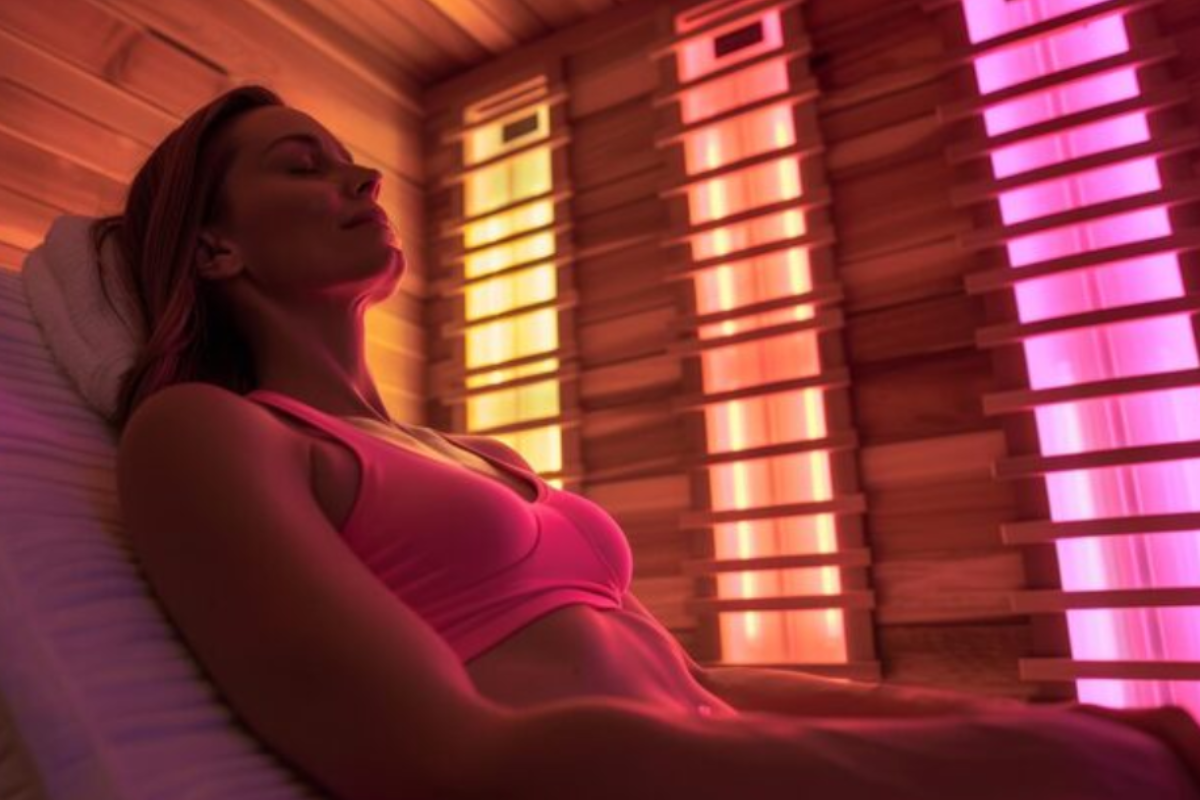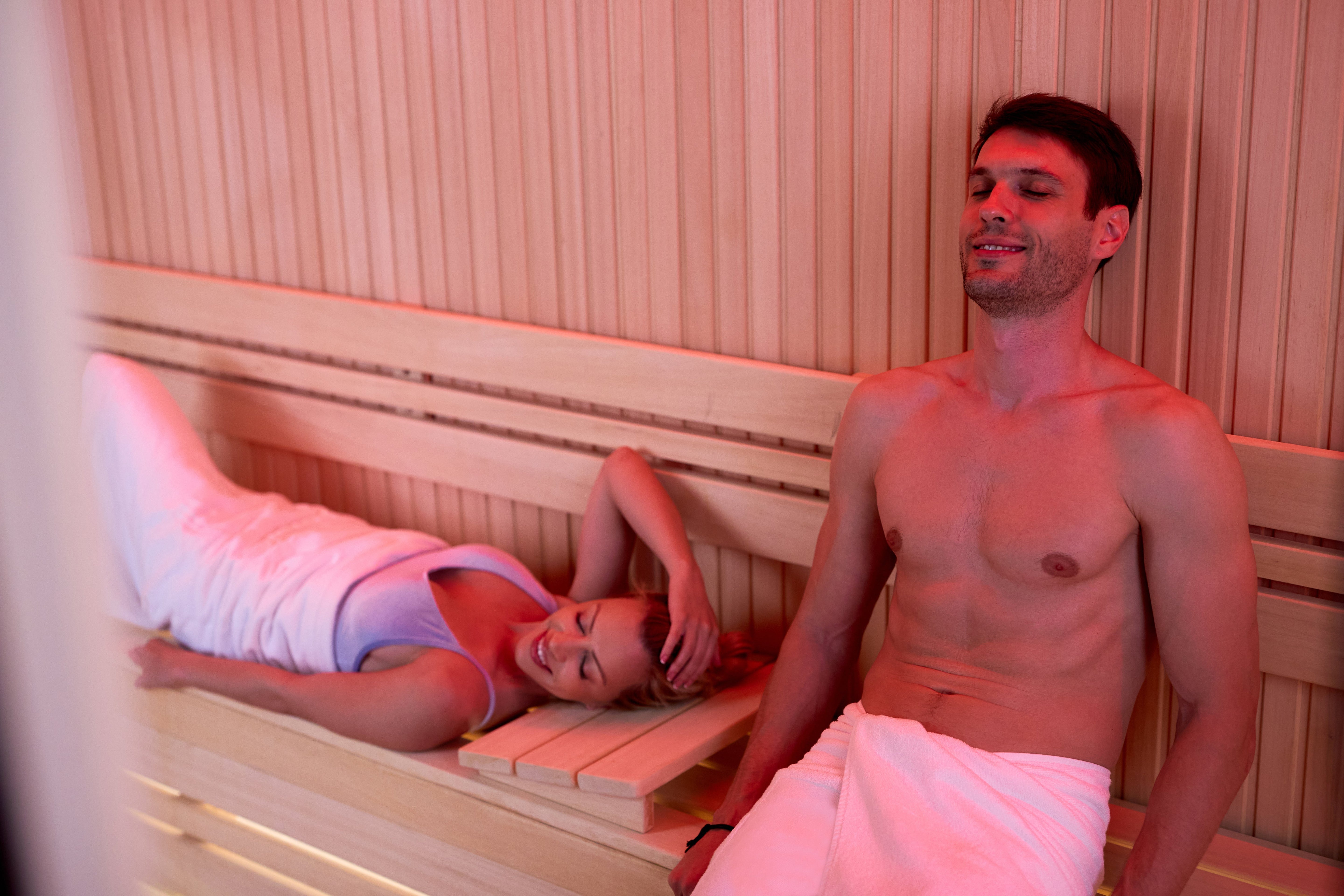preWhen it comes to modern wellness, two therapies often rise to the top: red light therapy and infrared saunas. Both harness the power of light, but they work in different ways and offer unique benefits depending on your health goals.
To know which therapy is perfect for you, you first need to understand their characteristics, benefits, and practical applications. For instance, red light therapy delivers targeted cellular stimulation without heat, while infrared saunas create therapeutic warmth that penetrates deep into tissues.
This comprehensive comparison will guide you through both therapies' science, benefits, and practical considerations, helping you make an informed decision for your wellness journey.
Understanding the Basics of Red Light Therapy and Infrared Saunas
What is Red Light Therapy?
Red light therapy, also known as photobiomodulation or low-level laser therapy (LLLT), uses specific wavelengths of red and near-infrared light to stimulate cellular processes. The treatment operates on the principle that specific light wavelengths can penetrate skin tissue and interact with mitochondria (the powerhouses of cells).
When cells absorb these specific wavelengths, they trigger biochemical reactions that increase ATP (adenosine triphosphate) production, the energy currency of cells. This cellular energy boost promotes healing, reduces inflammation, and stimulates various regenerative processes throughout the body.
The therapy doesn't rely on heat to create its effects. Instead, it works through photochemical reactions at the cellular level, making it different from heat-based therapies.
Types of Red and Near-Infrared Light
Red light therapy uses two primary wavelength ranges:
1. Red Light (620-750 nanometers):
This visible red light penetrates skin tissue to 2-3 millimetres. It's effective for surface-level treatments, including skin health, wound healing, and superficial muscle recovery.
2. Near-Infrared Light (750-1100 nanometers):
This invisible light penetrates deeper into tissues, reaching muscles, joints, and bones. It's more effective for deeper therapeutic applications like muscle recovery, joint health, and cognitive support.
Many modern devices combine both wavelengths to address surface and deep tissue concerns comprehensively.
Types of Red Light Therapy Devices
Red light therapy devices come in various forms to suit different needs and budgets:
-
LED Panels:
Large panels offering full-body or targeted area treatment. These typically range from small desktop units to room-sized panels for comprehensive coverage.
-
Handheld Devices:
Portable units are perfect for spot treatments and travel. These are ideal for targeted therapy on specific areas like joints or skin concerns.
-
Light Therapy Masks:
Facial devices are designed specifically for skin treatments, often featuring hundreds of LED bulbs arranged to cover the entire face.
-
Wearable Devices:
Flexible LED strips or wraps can be positioned on specific body parts for hands-free treatment.
Benefits of Red Light Therapy
1. Cellular Repair and Collagen Production
Red light therapy is widely recognized for its ability to stimulate cellular regeneration at a mitochondrial level. When red and near-infrared light penetrate the skin, they activate cytochrome c oxidase, a key enzyme that boosts ATP (energy) production within cells. This increase in cellular energy improves fibroblast activity, leading to greater collagen and elastin synthesis, the proteins essential for skin elasticity and firmness.
As a result, red light therapy is often used in anti-aging treatments to reduce fine lines, improve skin texture, and promote a more youthful appearance. It’s also beneficial for scarring and stretch mark reduction.
2. Hair Growth Stimulation
One of the lesser-known but well-supported benefits of red light therapy is its ability to stimulate hair follicles and slow or reverse hair loss, particularly in people with androgenic alopecia. The treatment works by improving blood circulation to the scalp, delivering more oxygen and nutrients to dormant follicles, and reactivating their growth cycle.
Clinical trials have shown that consistent red light exposure (typically using wavelengths around 630–670nm) can increase hair density and thickness in both men and women, mainly when used early in the hair loss.
3. Wound Healing
Red light therapy improves tissue repair and inflammation control, making it valuable for both acute injuries and chronic wounds. The light penetrates damaged skin or muscle tissue, accelerating ATP production, stimulating angiogenesis (formation of new blood vessels), and reducing oxidative stress. These combined effects speed up healing and reduce the risk of infection or scar formation. Red light therapy is often used post-surgically or for slow-healing wounds such as diabetic ulcers and pressure sores.
4. Spot Treatment Flexibility
Unlike full-body treatments, red light therapy can be highly targeted, allowing users to direct light precisely where needed. This makes it effective for treating localized issues such as acne breakouts, joint inflammation, tendon injuries, or sore muscles without affecting surrounding tissues. This level of precision reduces potential side effects and makes it easier to tailor treatment times and intensity for different areas of the body.
Worried about radiation levels? Our infrared saunas emf guide explains how low‑EMF panels keep exposure well below safety limits.
What is an Infrared Sauna?
Finnmark FD-2 Full Spectrum 2-Person Infrared Sauna
Infrared saunas emit radiant heat that directly warms your body's tissues. This internal heating mechanism activates sweat glands more efficiently while maintaining comfortable air temperatures. The result is a more tolerable experience that still produces heat therapy's cardiovascular and detoxification benefits.
The direct heating method means infrared saunas can be more comfortable for those who find traditional saunas too intense while delivering profound therapeutic effects.
Types of Infrared Waves
Infrared saunas utilize three types of infrared wavelengths:
-
Near-Infrared (700-1,400 nanometers):
These are the shortest and most surface-level wavelengths. Near-infrared primarily targets the outer layers of the skin, making it effective for cell regeneration, wound healing, and collagen production.
Because it overlaps with the light used in red light therapy, near-infrared is often praised for supporting skin health, reducing inflammation, and accelerating tissue repair. It’s commonly used for post-surgical healing and cosmetic skin treatments.
-
Mid-Infrared (1,400-3,000 nanometers):
Mid-infrared waves penetrate more deeply than near-infrared and are most associated with improving blood circulation and relieving muscle and joint pain. These wavelengths help increase tissue oxygenation, reduce stiffness, and promote greater flexibility, making them especially beneficial for athletes or individuals recovering from injury. Mid-infrared also contributes to raising the heart rate in a way that mimics mild cardiovascular exercise.
-
Far-Infrared (3,000-100,000 nanometers):
Far-infrared rays reach the deepest tissues and are best known for generating an intense sweating response without overheating the air around you. Far-infrared is particularly effective for detoxification, metabolic stimulation, and cardiovascular conditioning. Because of their profound tissue impact, far-infrared saunas are widely used for muscle relaxation, chronic pain relief, and stress reduction.
-
Full-spectrum infrared
Full-spectrum saunas combine near, mid, and far infrared wavelengths in a single unit to offer a comprehensive therapeutic experience. Full-spectrum saunas provide layered benefits, including skin rejuvenation, improved circulation, deep detox, and muscle recovery by delivering all three types of infrared light. This versatility makes them ideal for users with various health goals, especially those seeking all-in-one support for skin, muscles, and internal systems.
Still deciding which wavelength suits you best? This near vs far infrared saunas guide compares penetration depth, detox power, and skin benefits in plain language.
Benefits of Infrared Saunas
1. Cardiovascular Conditioning
Infrared sauna places the body in a state of mild thermal stress, which causes the heart to work harder to maintain a stable core temperature. As a result, heart rate increases, blood vessels dilate, and circulation improves, similar to the effects of low to moderate intensity exercise like brisk walking.
Dynamic Venice Elite 2-Person Ultra Low EMF Far Infrared Sauna
Over time, this repeated cardiovascular stimulation can support lower resting blood pressure, improved vascular function, and potentially a reduced risk of cardiovascular disease. Some long-term studies from countries like Finland have even linked regular sauna use with lower rates of stroke and sudden cardiac death, suggesting measurable heart health benefits when sessions are consistent.
2. Calorie Burning and Weight Support
Although infrared saunas shouldn’t replace a balanced diet or physical activity, they can be a helpful addition to a weight management plan. The elevated heart rate and body temperature during a sauna session increase the body’s energy expenditure, resulting in calorie burn that continues briefly after the session ends. This temporary metabolic boost can be especially beneficial for individuals managing chronic conditions that limit their ability to exercise.
3. Muscle Recovery and Pain Relief
One of infrared saunas' most widely appreciated benefits is their ability to support muscle recovery and relieve pain. The deep, penetrating heat reaches muscles and joints, increasing blood flow and delivering oxygen-rich nutrients to tissues needing repair. This makes infrared saunas especially useful after intense physical activity, helping reduce muscle soreness, joint stiffness, and exercise-related inflammation.
4. Full-Body Detox via Sweating
Unlike traditional saunas that rely on extremely hot air, infrared saunas heat the body directly, promoting deep, consistent sweat at a lower ambient temperature. This prolonged sweating encourages the release of toxins, heavy metals (like lead and mercury), BPA, and other metabolic waste that accumulate in fat cells and skin tissue.
Health Benefits of Red Light Therapy and Infrared Saunas
Here are the top benefits of red light therapy
1. Improves Skin Health
Both therapies promote skin health through different mechanisms. Red light therapy stimulates collagen production and cellular repair, while infrared saunas improve circulation and promote detoxification through sweating. Combined, these effects can lead to improved skin texture, reduced signs of aging, and better overall skin appearance.
2. Reduces Inflammation
Chronic inflammation underlies many health conditions. Red light therapy reduces inflammation through cellular pathways that decrease inflammatory markers. Infrared saunas combat inflammation through heat shock protein activation and improved circulation that helps clear inflammatory compounds.
3. Induces Mood and Stress Relief
Both therapies positively impact mental well-being. Red light therapy may influence neurotransmitter production and circadian rhythms, while infrared saunas trigger endorphin release and activate the parasympathetic nervous system, promoting relaxation and stress relief.
4. Supports the Body Detoxification Process
While working through different mechanisms, both therapies support the body's natural detoxification processes. Red light therapy enhances cellular energy production, supporting organ function. Infrared saunas promote detoxification through increased sweating and improved circulation.
Differences between Red Light Therapy and Infrared Sauna
1. Cellular Stimulation vs Thermal Therapy
The fundamental difference between these therapies lies in their mechanisms of action.
Red light therapy works through photobiomodulation – a process where specific light wavelengths trigger cellular responses without generating heat. This stimulation improves mitochondrial function, increases ATP production, and promotes cellular repair processes.
Infrared saunas, on the flip side, operate through thermal therapy, using heat to create physiological changes. The warming effect:
- Increases heart rate,
- Promotes circulation,
- Activates sweat glands, and
- Triggers heat shock proteins that provide protective and regenerative benefits.
These different mechanisms mean the therapies can complement each other while addressing distinct aspects of health and wellness.
2. Targeted Light vs Full-Body Heat Exposure
Red light therapy offers precision targeting. You can direct specific wavelengths to areas of concern, whether a healing wound, aging skin, or sore muscles. This targeted approach allows for customized treatment protocols based on individual needs.
Infrared saunas, however, provide full-body exposure to therapeutic heat. While you can't target specific areas as precisely, the comprehensive warming effect benefits multiple body systems simultaneously, from cardiovascular to lymphatic to detoxification pathways.
3. Temperature and Sensation
Red light therapy sessions involve no significant heat generation. Users may feel mild warmth from LED devices, but this is minimal compared to heat-based therapies. The lack of heat makes it comfortable for extended sessions and suitable for those who cannot tolerate high temperatures.
This temperature-neutral approach means you can use red light therapy while reading, working, or relaxing without the physical stress of heat exposure.
Infrared saunas create a profound warming sensation that penetrates deep into tissues. Users experience gradual heating that promotes sweating, increased heart rate, and the relaxation response associated with heat therapy.
The sweating mechanism serves multiple purposes: detoxification, thermoregulation, and the release of endorphins that create the characteristic post-sauna relaxation and well-being.
4. Session Format and Duration
Red light therapy sessions typically last 10-20 minutes, depending on the device's power and treatment goals. The shorter duration makes it easy to incorporate into daily routines without time commitment.
Infrared sauna sessions generally range from 15-45 minutes, with beginners starting shorter and gradually increasing duration as tolerance builds. The longer sessions allow for the gradual heating and full activation of heat-induced benefits.
5. Frequency and Ease of Use at Home
Red light therapy can be used daily without adverse effects. Many users incorporate it into their morning or evening routines, making it convenient for regular use.
Infrared saunas are typically used 3-4 times weekly, allowing recovery between sessions. While home units are available, they require more space and electrical considerations compared to compact red light devices.
Red Therapy vs Infrared Saunas: Which One Should You Choose?
Choose red light therapy if your primary goals include:
- Skin rejuvenation and anti-aging
- Targeted treatment of specific areas
- Daily use without heat exposure
- Wound healing or hair growth
- Precise, controlled therapy sessions
Red light therapy is ideal for those who want therapeutic benefits without the time commitment, space requirements, or heat exposure of saunas.
Choose Infrared Sauna if your priorities include:
- Comprehensive detoxification
- Cardiovascular conditioning
- Deep muscle relaxation
- Stress relief through heat therapy
- Full-body wellness approach
Infrared saunas are perfect for those who enjoy heat therapy and want a complete wellness experience that addresses multiple health aspects simultaneously.
Overall:
Consider combining both therapies for improved results. Many wellness enthusiasts find that combining both therapies provides complementary benefits. Red light therapy can be used daily for targeted concerns, while infrared saunas provide periodic full-body conditioning and detoxification.
This combination approach allows you to address specific health concerns and optimize overall wellness.
Your Quick Guide to Red Light vs Infrared Sauna Benefits
|
Feature |
Red Light Therapy |
Infrared Sauna |
|
Mechanism |
Non-thermal light-based therapy that stimulates cellular energy (photobiomodulation) |
Radiant heat penetrates deep into tissues, triggering detox, circulation, and relaxation |
|
Primary Benefits |
Skin rejuvenation, wound healing, inflammation reduction, hair growth |
Cardiovascular conditioning, detoxification, pain relief, stress reduction |
|
Best For |
Localized concerns, daily use, heat-sensitive users |
Full-body wellness, deep muscle therapy, heat therapy lovers |
|
Wavelength Range |
620–1100 nm (red and near-infrared) |
700–100,000 nm (near-, mid-, and far-infrared) |
|
Heat Sensation |
Cool or mildly warm — no sweating |
Intense full-body heat and sweat |
|
Session Duration |
10–20 minutes |
20–45 minutes |
|
Use Frequency |
Daily |
3–4 times per week |
|
Device Size & Setup |
Compact, travel-friendly; easy home use |
Larger footprint; dedicated home setup |
|
Customizability |
Treat specific areas like joints or skin |
Less precise targeting; full-body exposure |
|
Time Commitment |
Quick sessions; fits into busy routines |
Requires dedicated time for setup and cool down |
|
Comfort Level |
Ideal for those who dislike heat or sweating |
Great for those who enjoy warmth and relaxation |
Before you set a budget, the infrared sauna cost guide breaks down purchase prices, installation add‑ons, and long‑term electricity costs.
Final Thoughts — Which Therapy is Right for You?
The fundamental distinction between red light therapy and infrared saunas lies in their approach to wellness.
Red light therapy provides targeted, cellular-level stimulation without heat, making it ideal for skin health, wound healing, and localized pain. It excels at:
- Targeted treatment of particular areas
- Daily use convenience
- Skin rejuvenation and anti-aging
- Cellular repair and wound healing
- No heat exposure requirements
Infrared saunas, on the other hand, offer comprehensive heat therapy that promotes cardiovascular conditioning, detoxification, and full-body relaxation. Use infrared saunas for:
- Full-body detoxification
- Cardiovascular conditioning
- Deep muscle relaxation
- Stress relief through heat therapy
- Comprehensive wellness experience
In addition, the decision between red light therapy and infrared saunas doesn't have to be either/or. Many wellness enthusiasts find combining both therapies provides the most comprehensive approach to health optimization. Red light therapy can address specific concerns precisely, while infrared saunas offer the broader wellness benefits that support overall health and vitality.
Your choice should align with your health goals, lifestyle preferences, and practical considerations. Luckily, at premiumsaunas.com, you’ll find various sauna options, including models with integrated infrared and full-spectrum technology units. If you’re unsure where to start, our team is here to help you make an informed decision that fits your wellness routine.




